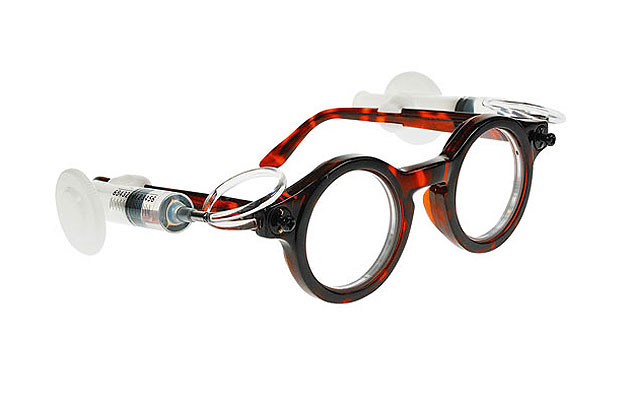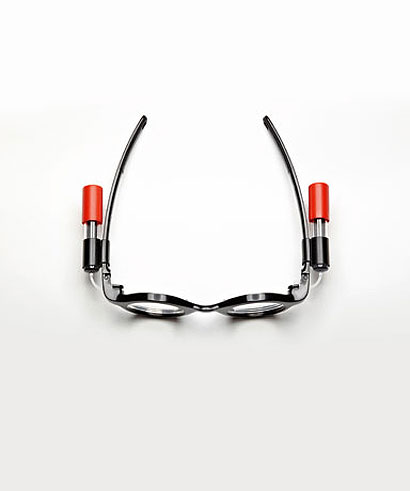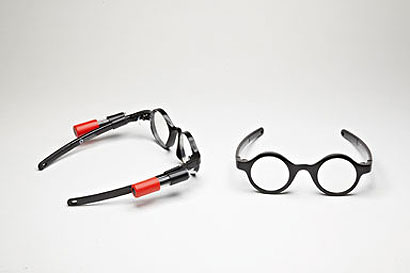|
|
||
|
A professor of atomic physics, a team of scientists and two industrial designers have come up with a pair of glasses so simple to use that you can adjust the prescription yourself There have been several high-profile attempts to bring low-cost computing and its educational benefits to children in the developing world, but the more pressing problem of intended users being able to see a laptop or tablet – let alone a blackboard – in the first place remains. The Oxford-based Centre for Vision in the Developing World estimates that there are 100 million young people who have poor vision. The Child ViSion glasses are an elegant attempt to address this problem, and the accompanying difficulty of there being nowhere near enough opticians in most parts of the world. The glasses, which won this year’s visitor’s vote in the Design Museum’s Designs of the Year, are the product of years of research and testing, and the efforts of many collaborators. In 1985, Joshua Silver, an experimental atomic physicist at Oxford University, came up with the idea of self-refracting glasses: “I found I could correct my own myopia very accurately with a variable power lens I made,” he explains. He spent 20 years on and off developing the idea into what eventually became a self-adjustable pair of glasses called the Adspecs. The lens for the Adspecs consists of two flexible membranes, protected by a hard plastic layer, which are filled with silicone oil. To change the power of the lenses, you turn a wheel on a syringe on each arm, which adds or subtract oil from the space between the membranes. As the lens shape changes, so does its refractive index. So far, some 50,000 pairs of the original Adspecs have been distributed in 20 countries around the world. “They work very well – and are the only self- refraction eyeglasses which have been evaluated in trials with both adults and teenage myopes,” Silver says. Silver founded the non- profit Centre for Vision in the Developing World and began work on the Child ViSion glasses in March 2011 to adapt the Adspecs for children. With an urgent funding deadline to meet, the in-house design team called in Goodwin Hartshorn, a London-based industrial design consultancy, to work on an improved design.
Edward Goodwin and Richard Hartshorn, who met when they were studying industrial design at the RCA, have developed projects including high-end speakers, cutting-edge surgical instruments, a urinal and even a garlic crusher. Edward Goodwin says that he and his partner Richard Hartshorn try to create “elegant solutions to complex problems”, and for this project they had only five months or so to work on the glasses. Goodwin explains the multiple constraints they were given: the glasses had to be tool free to use, they needed to fold up, and they needed to fit as many people and types of face as possible. As Hartshorn says, “the [Adspecs] are amazing, but they’re also packed full of problems”. They’re expensive to make and bubbles form inside the lenses. “Loads of these just crack at the hinges,” Hartshorn adds.t Goodwin Hartshorn was also asked to invent an adjuster that could change the power of the lenses at a rate of 1 dioptre a second. “If you move it too slowly,” Goodwin explains, “Your eyes start to self-correct, you accommodate.” To replace the syringes (which make the Adspecs difficult to ship as the arms don’t fold down properly), Goodwin Hartshorn came up with a compact mechanism that delivers the silicone oil with “the same sort of action you get from a fountain pen converter”.
The Child ViSion glasses range from 0 to -5 dioptres (the Adspecs have a much bigger range from -6 to +6) and they have one fixed lens and a membrane on the back – “So they’re a bit more robust, they’re just a bit more protected,” Goodwin says. The Adspecs require a screwdriver to remove the syringes, whereas the Child ViSion glasses have buttons, which come off once the glasses have been focused correctly. When it came to designing for different ages and face shapes, Goodwin Hartshorn did consult the various anthropomorphic databooks which exist, “but more than that, what we actually did is we went to Mossbourne Academy, which is round the corner”. The school’s pupils come from such a wide range of backgrounds that by measuring hundreds of pupils, for interpupillary distance and headwidth, Goodwin Hartshorn had enough data to work with. The glasses remain round as “The simplest, most delicate form of frame you can make is circular, and anything else, you can only go oversize,” Hartshorn says. Or, as Goodwin puts it, “Effectively we’re making little Le Corbusiers around the world.” |
Words Fatema Ahmed |
|
|
||






















